The post The Top TV and Radio Stations in Kenya – 2024 appeared first on GeoPoll.
]]>The media landscape in Kenya continues to evolve, with television and radio remaining key sources of news, entertainment, and engagement for millions of people. GeoPoll’s Audience Measurement (GAM) data from January to December 2024 offers insights into the most-watched television stations and most-listened-to radio stations nationwide. This report provides an overview of audience preferences, peak listening and viewing times, and regional radio dominance.
Understanding these general trends is essential for broadcasters, advertisers, and media planners looking to make data-driven decisions in a highly competitive space.
As you read through this overview, remember that this report provides just a high-level summary of audience trends in 2024. There are usually month-by-month and week-by-week changes that are not accounted for in this report. For deeper insights, such as hourly audience fluctuations, detailed regional breakdowns, advertising effectiveness, and content performance analysis, please reach out.
Top TV Stations in Kenya
Television continues to attract large audiences in Kenya, with Citizen TV maintaining its position as the most-watched channel. Other major stations such as NTV, KTN, KBC, and Maisha Magic East also reached a significant number of viewers to round up the Top 5.
Top 10 TV Stations by Reach (January – December 2024)
| Rank | Stations | Reach % |
| 1 | Citizen TV | 79 |
| 2 | NTV | 67.7 |
| 3 | KTN | 67.1 |
| 4 | KBC | 64.2 |
| 5 | Maisha Magic East | 64 |
| 6 | K24 | 63.4 |
| 7 | TV 47 | 62.5 |
| 8 | SuperSport | 61 |
| 9 | KTN News* | 60.7 |
| 10 | Akili Kids | 60.2 |
*KTN News has since been merged with KTN.
TV Viewership by Dayparts
- Early Morning (6:00 AM – 9:00 AM): Citizen TV and NTV dominate morning news and talk show programming, with a steady audience tuning in for breakfast bulletins and current affairs discussions.
- Mid-Morning (9:00 AM – 12:00 PM): While Citizen continues to lead this time block, Maisha Magic East and Inooro TV see increased viewership, particularly for local soap operas and lifestyle shows.
- Afternoon (12:00 PM – 7:00 PM): Akili Kids, KTN, and Supersport gain traction as children take charge of the remote controls and get home from school, as well as entertainment programs and sports segments.
- Prime-Time (7:00 PM – 9:30 PM): The peak of TV consumption in Kenya, dominated by Citizen TV, NTV, and KTN. Citizen TV peaks at 27.56 million viewers at 7:00 PM, while NTV attracts 17.47 million viewers at the same hour.
- Late Night (9:30 PM – Midnight): Viewership drops significantly post-prime time, with the exception of SuperSport as football lovers watch late-night fixtures.
Weekend and Special Programming Trends
- SuperSport experiences the biggest weekend growth, benefiting from football and other sports coverage.
- Local drama series on Maisha Magic East and Inooro TV sustain a strong weekend following.
- Weekend news bulletins remain crucial audience drivers for Citizen TV and NTV.
Top Radio Stations in Kenya
Despite the onslaught by social media and podcasts, radio continues to serve as a primary information and entertainment platform in Kenya, reaching a wide audience across urban and rural areas. The most listened-to stations at the national level in 2024 were:
| Rank | Stations | Reach % |
| 1 | Citizen | 72.4 |
| 2 | Radio Jambo | 68.6 |
| 3 | Radio Maisha | 68.1 |
| 4 | Milele FM | 64.2 |
| 5 | Classic 105 | 63.7 |
| 6 | Radio Taifa | 61 |
| 7 | Kiss FM | 59.6 |
| 8 | KBC English Service | 58.8 |
| 9 | NRG Radio | 36.9 |
| 10 | Kameme | 34 |
Breakfast shows are the prime of radio, with the highest radio listenership observed at this time block. Citizen Radio, Classic 105, Radio Jambo and Radio Maisha attract the highest listenership, driven by their lifestyle and political morning talk shows.
Regional Vernacular Radio Leaders
Despite the dominance of national giants, vernacular radio stations hold significant influence in their respective regions. In Central Kenya, Kameme FM and Inooro lead the market. Kaya and Msenangu are the top stations in the Coast region, while Ramogi and Mayienga are popular in the Lake Region. In Lower Eastern, Musyi and Mbaitu dominate, and in the Rift Valley, Chamgei and Emoo lead the airwaves. Egesa and Minto are prominent in South Nyanza, while Ingo and Mulembe are the top stations in Western Kenya.
| Region | Top Vernacular Station | Market Share (%) |
| Central | Kameme FM | 16.4% |
| Coast | Kaya FM | 7.3% |
| Lake | Ramogi FM | 22.8% |
| Lower Eastern | Musyi FM | 10.2% |
| Nairobi | Kameme FM | 5.1% |
| Rift | Chamgei FM | 8.1% |
| South Nyanza | Egesa FM | 20.6% |
| Western | Ingo FM | 4.1% |
| Upper Eastern | Meru FM | 8.2% |
GeoPoll Audience Measurement
GeoPoll provides real-time, data-driven insights into media consumption patterns in Kenya and across the world. Whether you need daily audience measurement, on-demand media analytics, or a customized report covering a specific time period, GeoPoll Audience Measurement offers the tools to help you make informed decisions for media advertising or programming.
How to access more insights:
- Subscribe for daily TV and radio ratings to track audience behavior in real-time.
- Request a custom report for any time period or audience segment.
- Analyze advertising impact to optimize marketing campaigns.
- Understand viewership trends per content type and broadcaster.
The post The Top TV and Radio Stations in Kenya – 2024 appeared first on GeoPoll.
]]>The post MEAL: Using Mobile to Track the Impact of Donor-Funded Projects appeared first on GeoPoll.
]]>Take the example of a MEAL tracker GeoPoll did with a partner in the development sector in South Sudan. The year-long project aimed to monitor food security interventions in real time using mobile-based surveys. GeoPoll used SMS surveys to collect feedback from thousands of beneficiaries every week for a year, allowing for immediate program adjustments and enhanced impact reporting to donors. This near real-time MEAL approach led to improved, continous decision-making and resource allocation.
MEAL Strategies for NGOs
Successful MEAL strategies rely on a combination of timely data collection, community engagement, and iterative learning. Organizations must focus on:
- Real-Time Monitoring: Frequent data collection ensures projects stay on track and allows for immediate adjustments.
- Impact Evaluation: Systematic assessment of long-term project outcomes helps in understanding what works and what doesn’t.
- Accountability Mechanisms: Engaging beneficiaries through mobile feedback loops improves project transparency and community trust.
- Data-Driven Learning: MEAL is not just about tracking; it’s about using insights to refine strategies and improve impact.
The Role of Mobile Data Monitoring
Mobile technology is revolutionizing MEAL by offering real-time, scalable data collection solutions. GeoPoll’s mobile-based surveys enable NGOs, donors, and policymakers to:
- Track Key Performance Indicators (KPIs) in Real Time: SMS, IVR, and mobile web surveys allow for frequent, remote data collection, reducing reliance on field visits.
- Enhance Reach and Representation: Mobile surveys ensure voices from hard-to-reach populations are included in evaluations.
- Improve Cost-Effectiveness: Mobile data collection reduces operational costs compared to traditional face-to-face methods.
- Increase Data Accuracy and Security: Automated data collection minimizes human error and provides instant digital records.
Mobile Tools for Donor Impact Reporting
Donors require transparent, data-backed impact reports to validate funding effectiveness. Mobile-based MEAL tools support this by:
- Enabling Quick Survey Deployment: NGOs can rapidly distribute surveys to beneficiaries, field staff, and stakeholders.
- Providing Dashboards for Live Data Visualization: Interactive dashboards offer real-time insights into project progress.
- Ensuring Continuous Feedback Loops: Mobile channels allow beneficiaries to report challenges or provide suggestions in real time.
- Supporting Remote Monitoring in Crisis Situations: Mobile data collection is invaluable for tracking projects in conflict zones, disaster responses, and remote regions.
The Bottomline
Recently, mobile-based MEAL solutions have transformed the way NGOs, donors, and policymakers track project success. With proven impact now a core concern for donors, organizations use mobile technology to enhance monitoring efficiency, improve accountability, and generate real-time insights that drive impactful decision-making. As digital tools become more accessible, integrating mobile into MEAL strategies will be key to ensuring the success of donor-funded projects worldwide.
For the last decade, GeoPoll has perfected mobile-based MEAL solutions tailored for emerging countries. Our platform enables real-time data collection, analysis, and impact reporting to drive data-informed decision-making. Learn more about how GeoPoll can support your MEAL strategies—contact us today!
The post MEAL: Using Mobile to Track the Impact of Donor-Funded Projects appeared first on GeoPoll.
]]>The post Over-the-counter self-medication in Africa appeared first on GeoPoll.
]]>Over-the-counter (OTC) medication plays a crucial role in healthcare across Africa, providing accessible and affordable treatment for common ailments without the need for a prescription. In many regions, OTC drugs serve as the first line of defence against illnesses due to limited access to formal healthcare facilities. Understanding consumer behaviour, availability, and regulatory frameworks is essential for ensuring the safe and effective use of OTC medications across the continent.
To better understand the perspectives of Africans on over-the-counter drugs, GeoPoll conducted a survey capturing insights into their accessability, usage, and challenges. This report highlights the key findings from the survey and sheds light on the current state of over-the-counter drugs usage across the continent.
Demographic Overview
The survey gathered feedback from 2,093 respondents in Ghana, Kenya, Tanzania, and Uganda. The participants ranged from 18-35 years old, with the largest share being between 25-35 years old (56%), and comprised 68% male and 32% female. A majority, (65%) are college degree holders. In addition, 76% stated that they reside in urban areas whereas 25% live in rural areas.
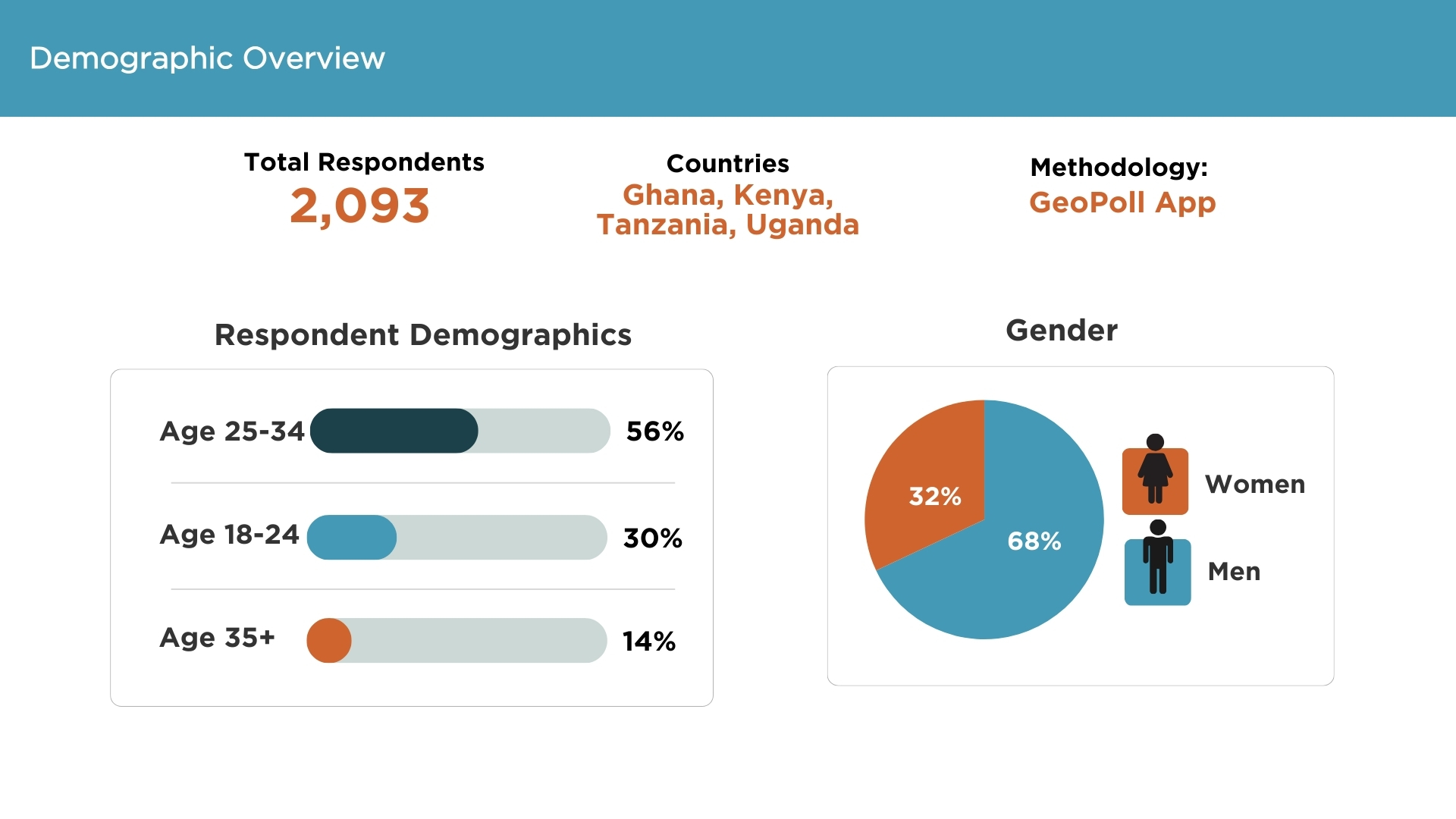
Key Findings
Over-The-Counter Self Medication
According to The World Health Organization; self-medication as “use of pharmaceutical or medicinal products by the consumer to treat self-recognized disorders or symptoms, the intermittent or continued use of a medication previously prescribed by a physician for chronic or recurring disease or symptom, or the use of medication recommended by lay sources or health workers not entitled to prescribe medicine.
The survey uncovered insights into the self-medication habits of respondents. A notable 42% admitted to occasionally turning to over-the-counter (OTC) medications without the guidance of a doctor. Meanwhile, a significant 26% reported that they frequently rely on these remedies to address their ailments. On the other end of the spectrum, 21% indicated they rarely self-medicate, while a smaller segment, comprising 13%, stated that they have never resorted to OTC solutions for their medication.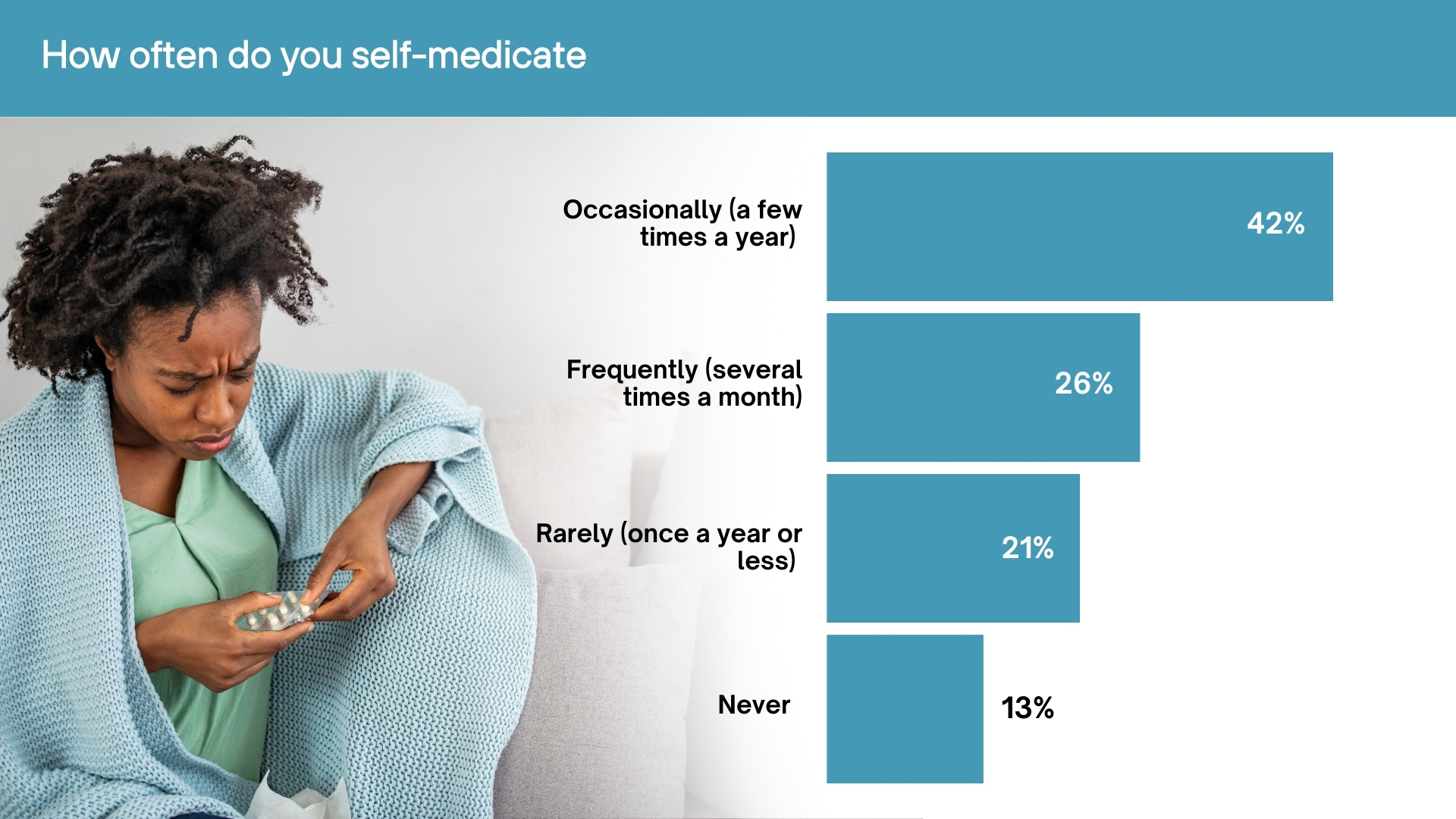
Place of purchase
A significant majority (86%) of individuals who reported purchasing over-the-counter (OTC) drugs indicated that they do so from pharmacies. In contrast, 7% of consumers prefer to obtain their medications from kiosks, while 6% choose supermarkets as their shopping venue. A smaller segment, comprising 2%, purchases their medicines from online stores.
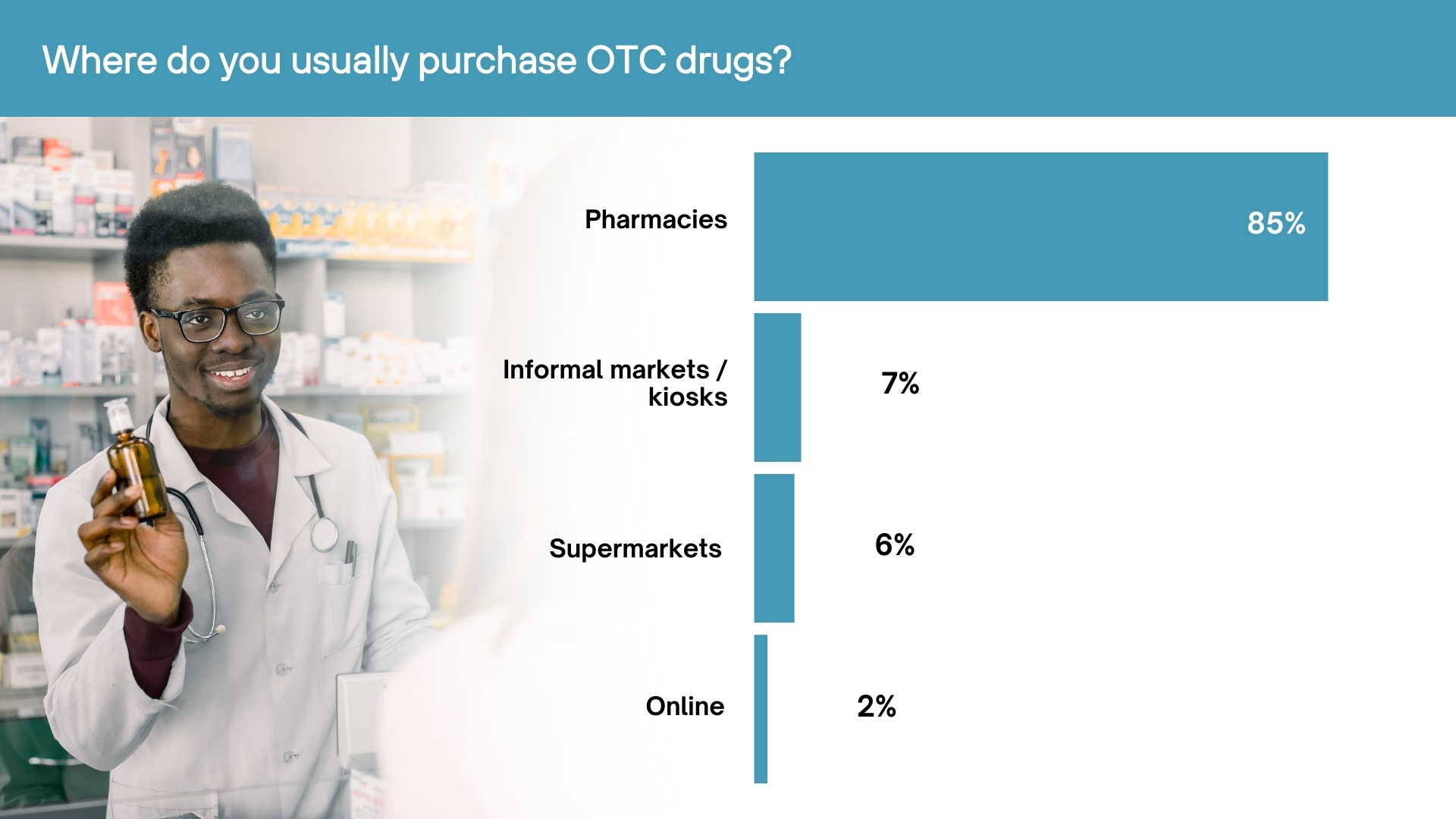
Consultation
The survey reveals that pharmacists are the most consulted source for health advice, with 53% of individuals preferring to seek their guidance. This trend is largely due to many people choosing pharmacies as their primary location for purchasing medications, often interacting directly with pharmacists who can suggest appropriate drugs. In contrast, 24% of respondents seek advice from doctors or physicians. Additionally, 14% rely on information from friends and family, while 6% turn to online platforms for guidance. Notably, 4% of individuals reported not consulting anyone for health-related advice.
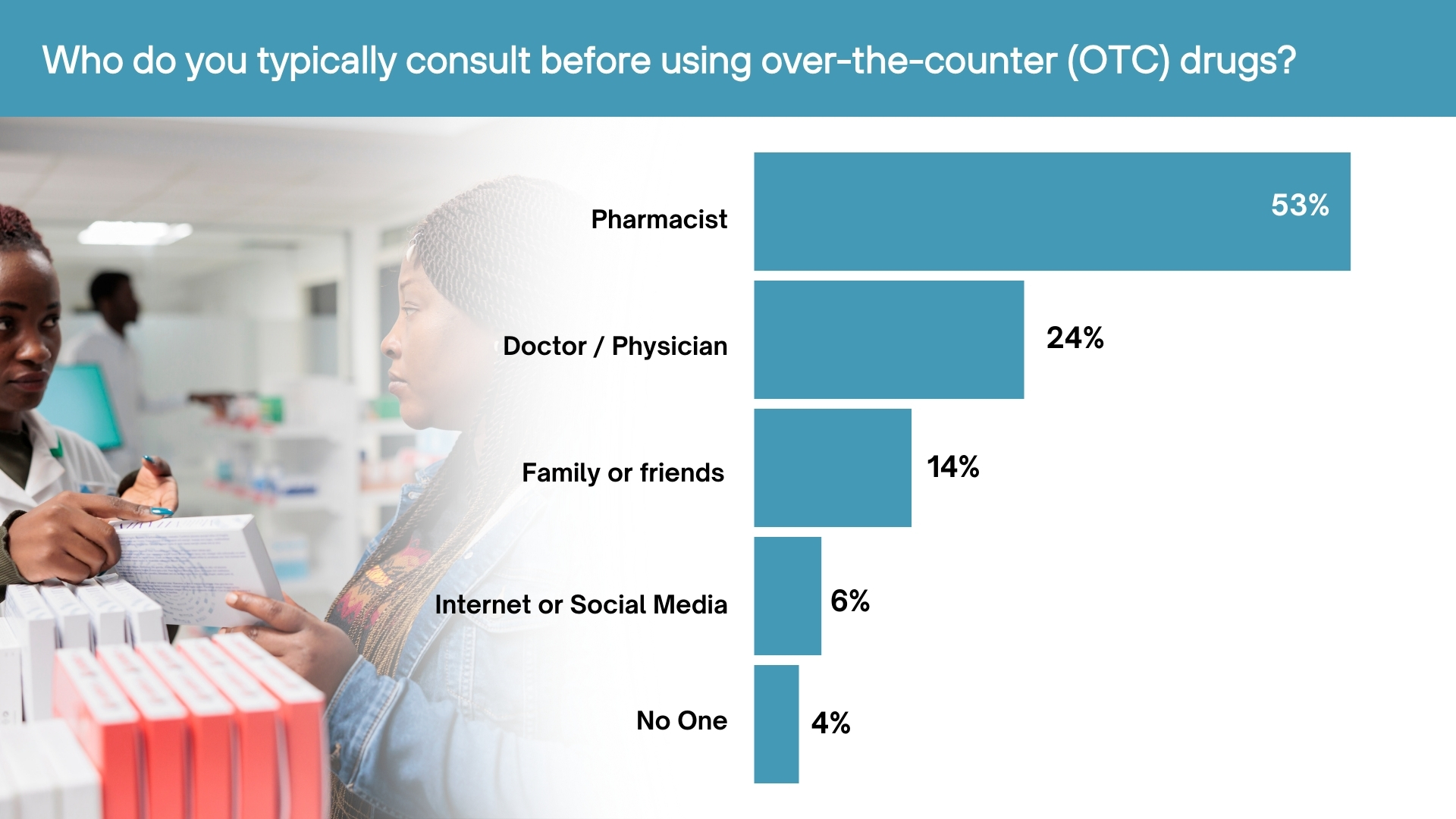
Most frequently used OTC drugs
- Pain relievers (paracetamol / ibuprofen) – (76%)
- Cold and flu medication – (70%)
- Cough syrup – (36%)
- Antibiotics – (31%)
- Antacids or digestive aids – (22%)
- Vitamins or supplements – (20%)
- Ointments – (14%)
- Antihistamines for allergies – (13%)
Pain relievers like paracetamol and ibuprofen are the most commonly used over-the-counter (OTC) medications, with 76% of consumers relying on them for relief. Cold and flu remedies are also widely used (70%), followed by cough syrups at 36%. Despite being prescription-based in many regions, antibiotics are obtained OTC by 31% of users. Antacids and digestive aids (22%), along with vitamins and supplements (20%), are also frequently purchased. Additionally, ointments (14%) and antihistamines for allergies (13%) contribute to the range of OTC treatments used for everyday health needs.
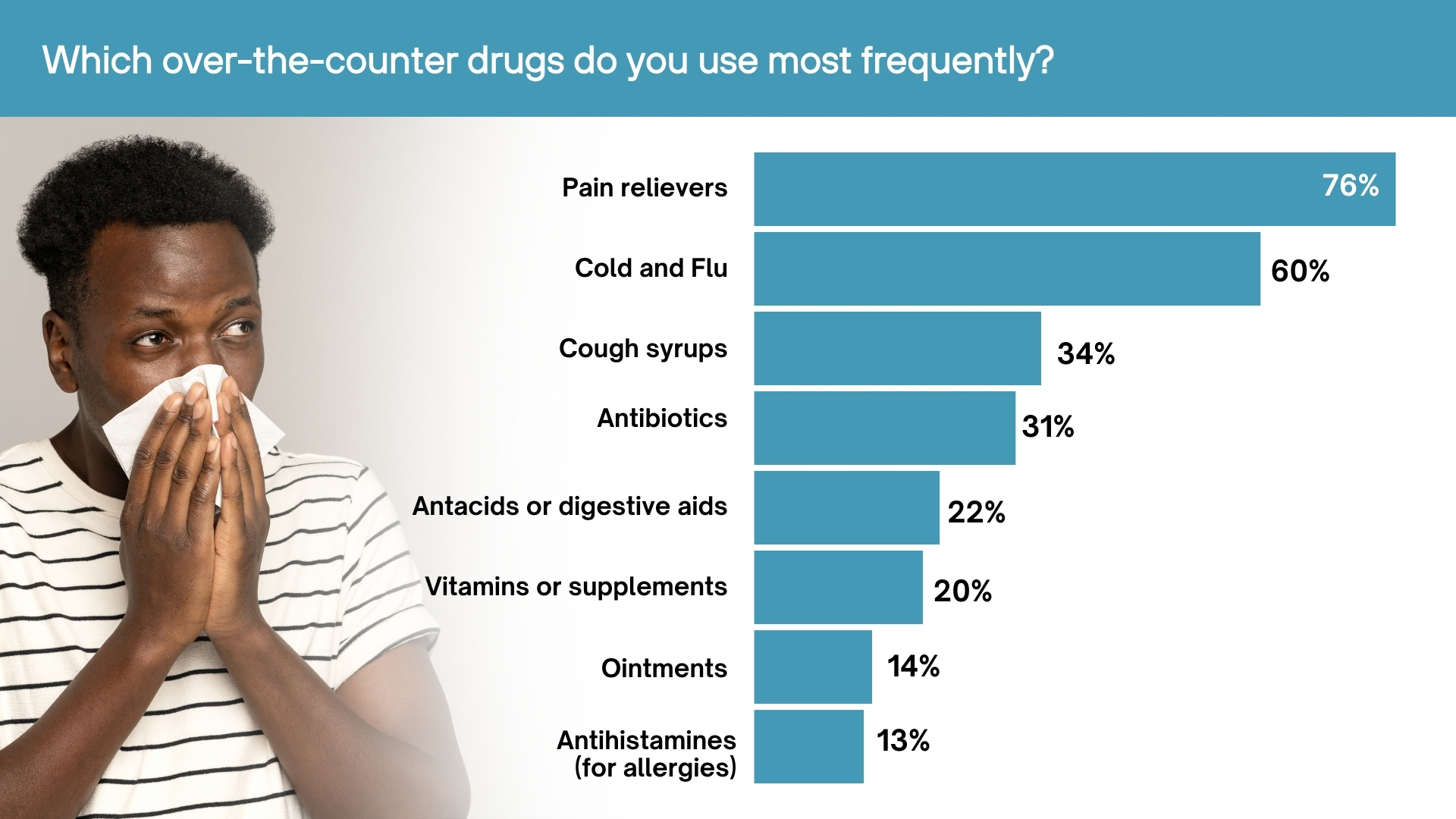
Dosage instructions
Survey results indicate that 66% of respondents consistently read dosage instructions before taking over-the-counter (OTC) medication, to ensure proper use. Meanwhile, 28% only read the instructions occasionally, while 7% rarely do so, highlighting potential risks associated with improper medication use.
Potential risks of OTC Self medication
Self-medication can pose significant risks and result in various complications and health problems. One potential danger of self-treatment is the possibility of misdiagnosing oneself and using inappropriate medication. Additionally, harmful interactions between drugs might happen due to incorrect dosages or misuse of medications.
From the survey, half of the respondents acknowledged being fully aware of the potential dangers associated with the over-the-counter self-medication. Meanwhile, 43% are aware of some risks but not all of them, and 8% do not recognize any risks at all.
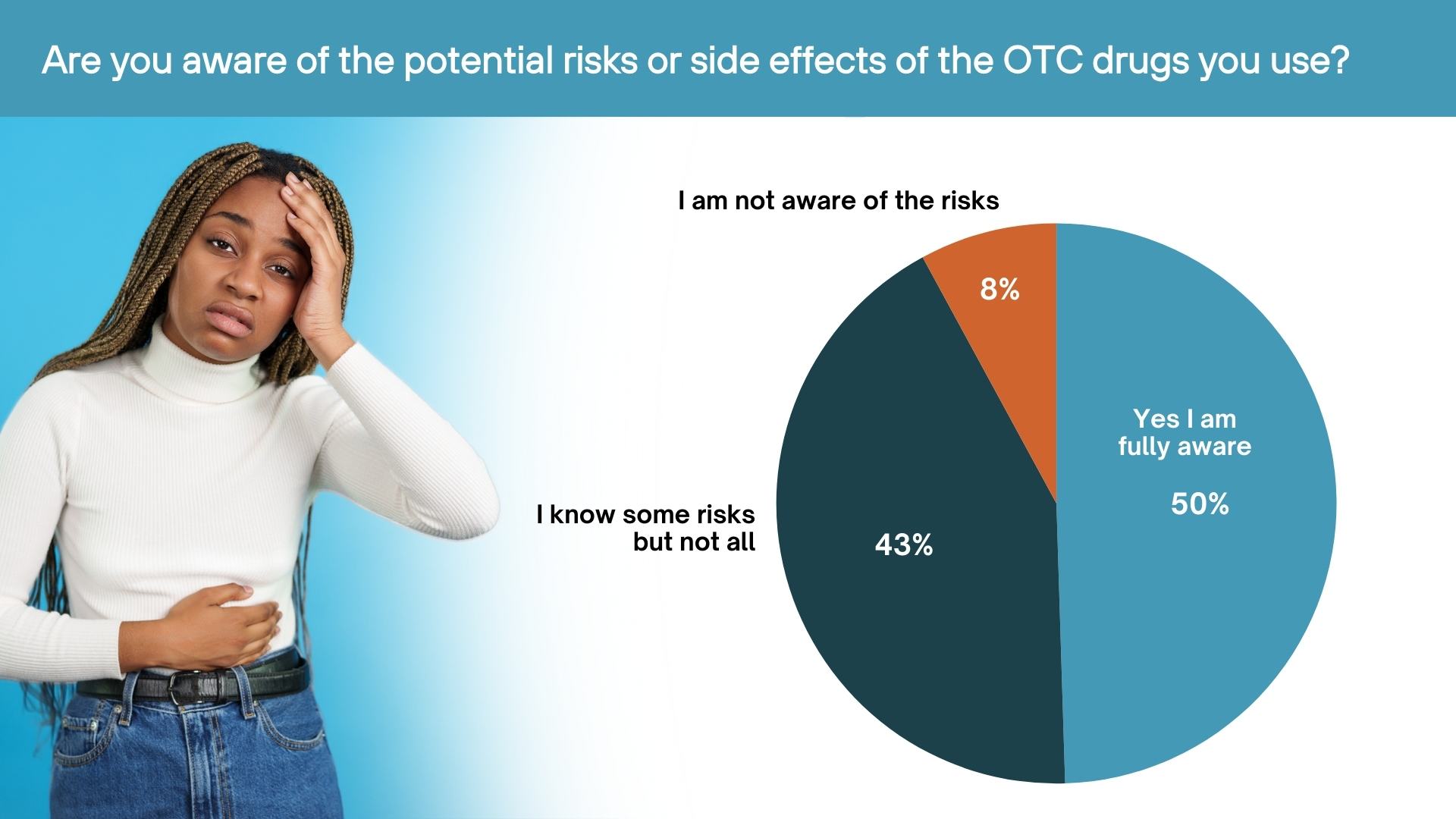
Side Effects of OTC Self medication
A striking 62% of the participants shared that they had never encountered any adverse effects from using over-the-counter (OTC) medications, highlighting a sense of confidence in these easily accessible treatments. Conversely, a notable 38% admitted to experiencing side effects during their use, shedding light on the complexities and varied reactions individuals may have to this form of medication.
Reasons for choosing self-medication
The primary reason for individuals opting for self-medication is cost, with 53% of respondents indicating that it is cheaper than visiting a doctor. Convenience also plays a significant role, as 26% of participants noted that self-medication is more accessible than seeking professional care. Additionally, 15% of those surveyed cited limited access to healthcare services as a reason for their choice, while a small percentage (2%) expressed greater trust in over-the-counter (OTC) drugs compared to healthcare professionals.
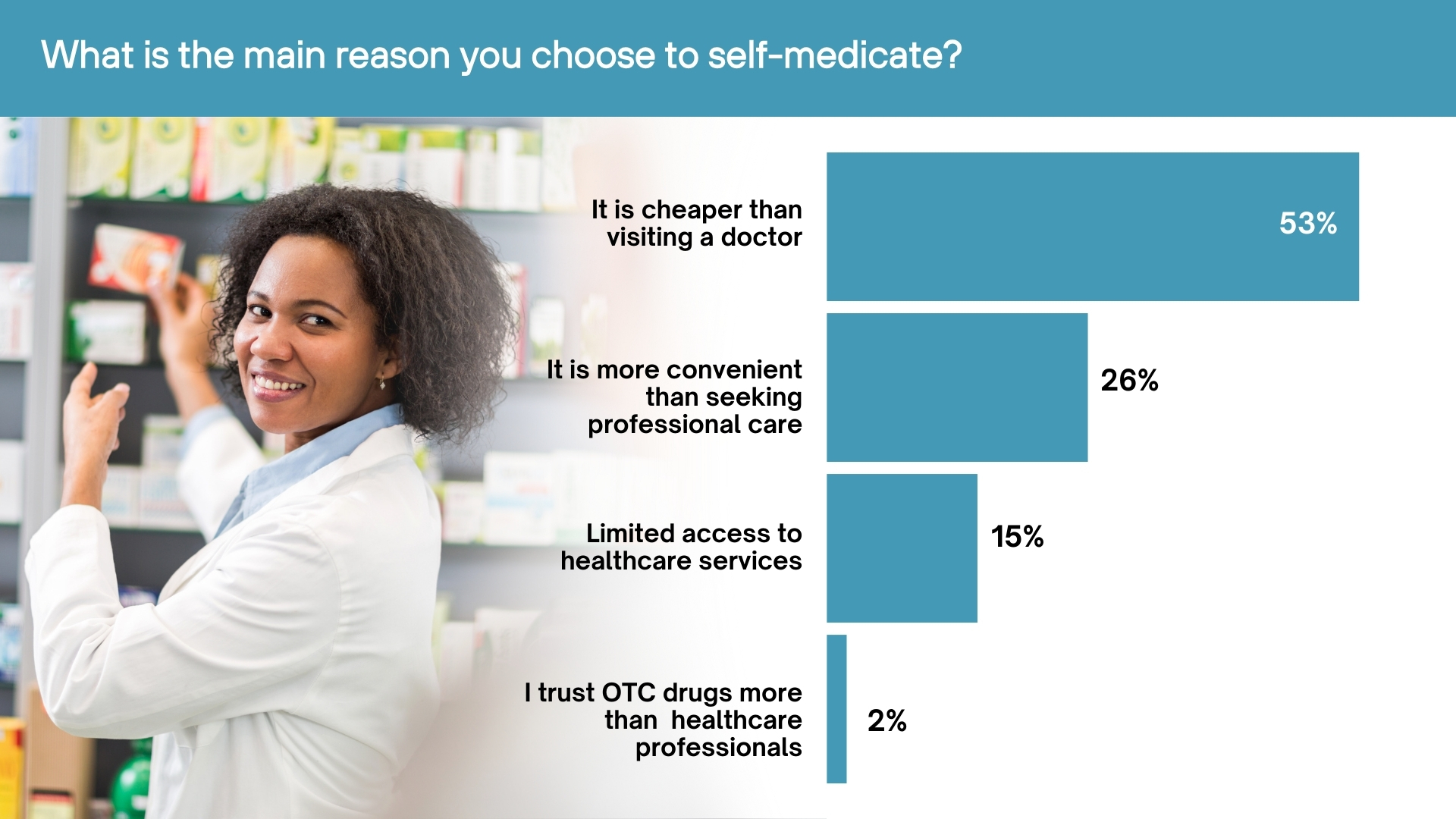
Is healthcare affordable?
Healthcare is typically viewed as unaffordable for many individuals in Africa, as most encounter considerable financial strain from high out-of-pocket expenses for medical care, restricted availability of public health insurance, and minimal government investment in healthcare relate to other global regions. This reality often thrusts individuals deeper into poverty when they require medical attention. According to WHO, The practice of out-of-pocket payments, warns the report, continues to place a financial burden on over 200 million people, including pushing over 150 million people into or deeper into poverty (latest data, from 2019) across the WHO Africa Region. It also exacts a heavy price on people’s health and hampersprogress in attaining universal health coverage.
In fact, globally, half of all people impoverished because of out-of-pocket payments live in Africa.
Ghana
Among those who were surveyed, 49% reported that healthcare is moderately affordable, while 30% indicated that it is not affordable at all, and 23% believed that healthcare is affordable in the nation.
Kenya
In Kenya, half of the respondents indicated that healthcare is somewhat affordable, while 31% asserted that it is not affordable at all, and 20% reported that it is affordable.
Tanzania
51% of individuals in Tanzania feel that healthcare is somewhat affordable, contrasting with Kenya and Ghana, where 37% reported that it’s very affordable and 14% expressed that it’s completely unaffordable.
Uganda
In Uganda, 53% of the respondents reported that healthcare is somewhat affordable, while 25% noted that it is very affordable, and 24% expressed that it is not affordable at all.
Access to healthcare
Across the continent, nearly half of those surveyed (49%) stated that getting healthcare services is somewhat easy. In addition, 28% of participants indicated that they can obtain necessary medications with a high level of ease. However, a notable 20% of those surveyed expressed that they encounter challenges when trying to access healthcare, considering it to be difficult, while a smaller group, comprising 4%, described the process as very difficult. This highlights a diverse range of experiences when it comes to healthcare accessibility across different regions.
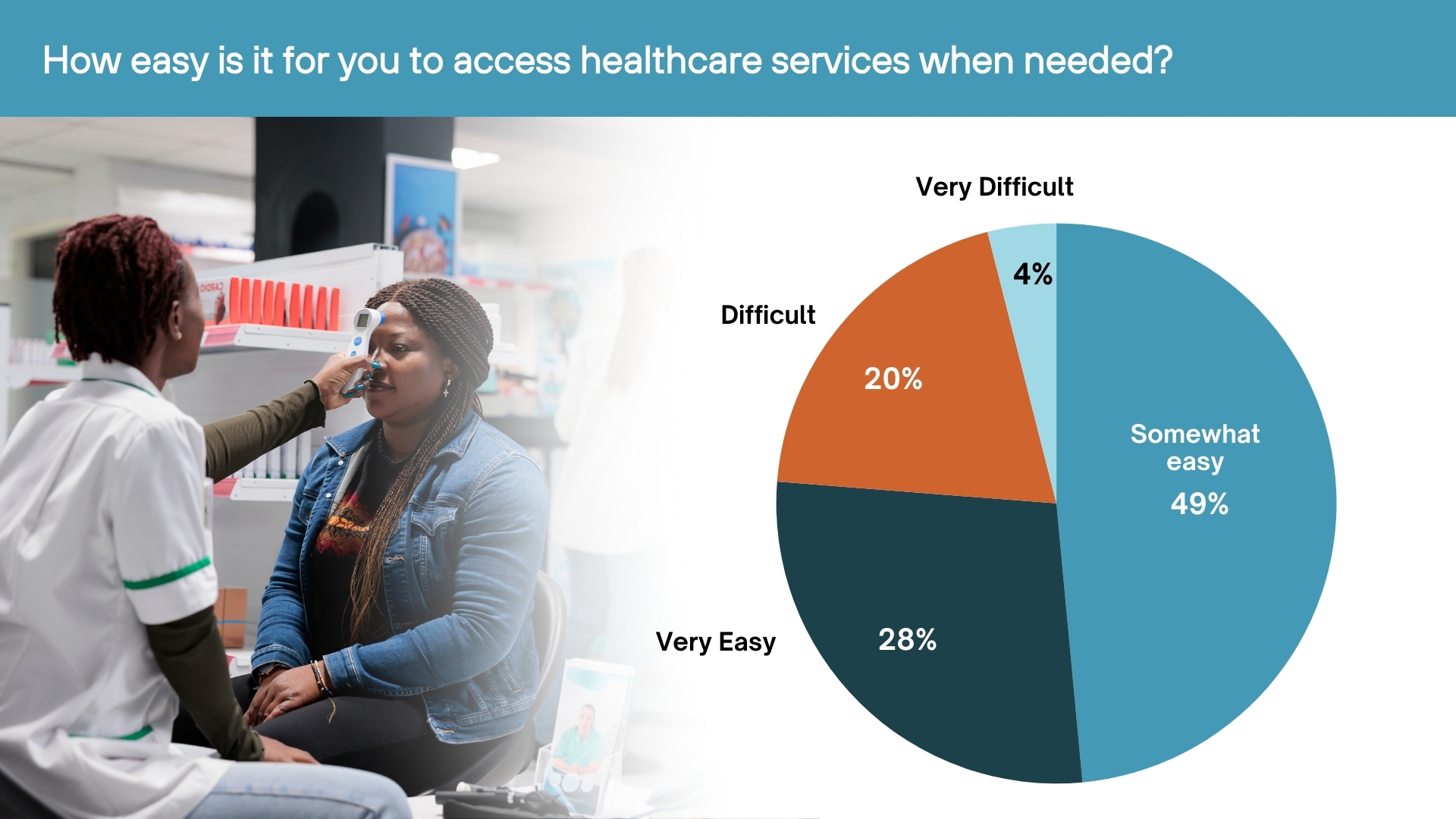
Professional healthcare vs Over the counter self medication
The survey indicated that a large majority, 93%, would choose professional medication if it were readily available and cost-effective. Conversely, a smaller group of participants, 7%, expressed that they would not seek professional healthcare.
Methodology/About this Survey
This Exclusive Survey was run via the GeoPoll mobile application between the 17th January and 5th of February 2025 in Ghana, Kenya, Tanzania and Uganda. The sample size was 2,093, composed of random GeoPoll app users between 18 and 35. Since the survey was randomly distributed, the results are slightly skewed towards younger respondents.
GeoPoll is committed to supporting pharmaceutical companies, health organizations, NGOs, and governments in future health challenges. Together, we can use data to inform targeted interventions, mitigate the impact of public health crises, and build more resilient health systems for the future. Our mobile-based surveys offer a unique and tried-and-tested way to gather insights on disease spread, public perception, and vaccine hesitancy, especially in under-resourced regions.
Please get in touch with us to get more details about our capabilities, explore more on healthcare, or other topics in Africa, Asia, and Latin America.
The post Over-the-counter self-medication in Africa appeared first on GeoPoll.
]]>The post Research Report: Voices from Central America – Economic Challenges, Migration Pressures, and Regional Security in 2025 appeared first on GeoPoll.
]]>This research—conducted via our Panama-based call center—highlights key regional challenges, including food insecurity, job instability, and the impact of major geopolitical events.
This study comes at a critical time when migration policies, economic development, and security measures are at the forefront of regional and international discussions. With insights drawn from 900+ interviews conducted via Computer-Assisted Telephone Interviewing (CATI), across the entire region, this report sheds light on the pressing issues affecting millions across Central America.
A sneak peek of the insights you will find in the report:
- Panama – Balancing Growth, the Darien Dilemma & the Recent Canal Crisis
- El Salvador – Security Success
- Guatemala – A Nation on Edge
- Honduras – Voice Security Concerns Amidst Economic Challenges
- Nicaragua – The Hidden Hardship
Dive Deeper – Download the Report
Download the GeoPoll Central America Migration Survey: Interim Report now for free to read the full interim findings and trends shaping the region.
Subscribe to be the first to get the final report, which will provide even deeper insights into migration drivers, economic instability, and security challenges across Central America. For any questions on the research and our capabilities, please contact us.
The post Research Report: Voices from Central America – Economic Challenges, Migration Pressures, and Regional Security in 2025 appeared first on GeoPoll.
]]>The post Building Better AI with High-Quality Training Data from Emerging Markets appeared first on GeoPoll.
]]>For years, artificial intelligence has suffered from a critical blindspot: its narrow, often homogeneous view of the world. Traditional AI development has been like looking through a keyhole, capturing only a tiny, limited perspective of human experience. Most machine learning models have been trained primarily on data from North America and Europe, creating systems that fundamentally misunderstand the vast majority of global human communication and context.
Consider language, the most nuanced form of human expression. Current AI systems excel in English and a handful of European languages but struggle dramatically with the linguistic diversity of regions home to billions of people. A conversational AI trained solely on American English will flounder when confronted with the dialects of Nigeria, the coded slang of Indonesian youth, or the linguistic variations of rural Panama communities.
Being representative of global populations is essential. Emerging markets, in particular, offer a wealth of untapped, high-quality information that can drive innovation and significantly improve AI models. But they also present unique challenges that require innovative data collection and processing solutions.
The Importance of Data Diversity in AI Development
For AI models to perform accurately across different demographics, they must be trained on datasets that represent the diversity of the world’s population.
AI systems learn and evolve based on the data they consume. Just as a well-rounded education requires diverse and comprehensive knowledge, robust AI models depend on high-quality AI data. The benefits of utilizing quality data include:
- Improved Accuracy: When models are trained on reliable and representative data, they can make more precise predictions and decisions.
- Reduced Bias: Diverse datasets help mitigate biases that often arise when models are trained on homogenous data sources.
- Enhanced Generalization: Exposure to a variety of scenarios and languages enables AI systems to perform better in real-world applications.
- Innovation Catalyst: Fresh perspectives and novel data points from different regions can inspire innovative applications and use cases.
However, much of the current AI training paradigm relies on data from well-established markets, which can limit the scope and adaptability of AI solutions on a global scale. the result has been biases that limit AI’s effectiveness in emerging economies. There has been a struggle to interpret accents, dialects, and cultural nuances in regions such as Africa, Asia, and Latin America.
The Potential of Emerging Markets
Emerging markets are rapidly evolving digital landscapes brimming with potential. They present a unique opportunity to enrich AI training datasets with insights that reflect a more diverse array of cultural, linguistic, and socioeconomic backgrounds. Here’s why these markets are so promising:
- Diverse Linguistic Data – Emerging markets are home to hundreds of languages and dialects. Integrating these into your AI models ensures better language understanding and processing. This is particularly critical for natural language processing (NLP) applications, where nuances in local language can make or break the effectiveness of a model.
- Cultural Nuance and Context – Data from emerging markets bring in cultural nuances that are often missing from datasets sourced predominantly from developed regions. This diversity can help reduce cultural bias, enabling AI to better understand and serve global communities.
- Real-World Relevance – The challenges and scenarios prevalent in emerging markets often differ significantly from those in more established regions. By incorporating these unique data points, AI systems can be trained to address a broader range of problems, making them more adaptable and effective in diverse environments.
- Economic and Social Impact – Investing in AI datasets from emerging markets doesn’t just improve technology—it also supports local innovation ecosystems. By acknowledging and utilizing local data, companies can contribute to economic growth and social progress in these regions.
Challenges of AI Training Data in Emerging Markets
Despite the need for diverse data and the huge potential, collecting high-quality training data in emerging markets comes with distinct challenges:
- Language and Dialect Complexity – Many regions have multiple languages and dialects that are not well-documented or digitized.
- Limited Digital Infrastructure – In areas with low internet penetration, mobile-first or offline data collection methods are essential.
- Privacy and Ethical Concerns – Compliance with local data regulations and ethical AI principles must be prioritized.
- Data Labeling and Annotation – High-quality AI models require accurate data labeling, which can be difficult to achieve at scale in emerging markets.
GeoPoll’s Solution: AI Data Streams
As AI applications expand globally, ensuring that training data reflects the voices and realities of people in emerging markets is critical. Companies looking to scale AI solutions must prioritize ethically sourced, high-quality datasets from these regions to build more inclusive and effective AI systems.
At GeoPoll, we are uniquely positioned to transform the landscape of AI training with our innovative approach to data collection—AI Data Streams. Our platform has amassed over 350,000 hours of diverse, representative, and high-quality voice recordings from 1 million+ individuals across Africa, Asia, and Latin America, structured and ready for LLM training. This treasure trove of audio data is more than just a record of conversations; it is a dynamic resource poised to revolutionize how large language models (LLMs) are trained.
The voice recordings, collected ethically and with respondent consent, capture the natural flow of language—intonations, accents, and conversational nuances that are often lost in text-only datasets. The diversity inherent in our recordings from emerging markets ensures that AI systems can learn from a wide range of linguistic inputs. This is especially critical for LLMs, which require vast amounts of high-quality AI data to understand and generate human-like language. With this rich, multilingual audio data, LLMs can become more adept at recognizing and processing a variety of dialects and accents, ultimately leading to more inclusive and culturally sensitive AI applications.
GeoPoll’s AI Data Streams bridges this gap by providing reliable, high-volume training data from Africa, Asia, and Latin America. By partnering with GeoPoll, organizations can drive AI innovation while supporting local data ecosystems and contributing to the responsible development of artificial intelligence.
To learn more about how GeoPoll can support your AI training data needs for emerging nations, contact us today.
The post Building Better AI with High-Quality Training Data from Emerging Markets appeared first on GeoPoll.
]]>The post Tackling Malnutrition in the Horn of Africa: The Role of Data in Strengthening Food Systems appeared first on GeoPoll.
]]>The Malnutrition Crisis in the Horn of Africa
The Horn of Africa, comprising countries Somalia, Ethiopia, Eritrea, and Djibouti, has one of the highest rates of food insecurity globally. According to the Food and Agriculture Organization (FAO), prolonged droughts and erratic rainfall patterns have drastically reduced agricultural productivity, leading to widespread hunger and malnutrition. In addition, conflict-driven displacement and economic disruptions further exacerbate the crisis, making access to nutritious food increasingly difficult for millions.
Malnutrition manifests in various forms, including acute malnutrition, stunting, and micronutrient deficiencies. In Somalia alone, UNICEF estimates that nearly half of all children under five are malnourished, with severe acute malnutrition (SAM) posing a life-threatening risk. Addressing this crisis requires more than food aid; it necessitates a data-driven, systems-based approach to enhance resilience and long-term food security.
The Power of Data in Strengthening Food Systems
Data-driven solutions are transforming how governments, NGOs, and development agencies respond to malnutrition. By collecting and analyzing real-time data, stakeholders can identify trends, predict food shortages, and implement targeted nutritional interventions. Key data-driven strategies include:
- Early Warning Systems
- Predictive analytics help identify regions at risk of food shortages by monitoring weather patterns, crop yields, and market prices.
- Organizations like the Famine Early Warning Systems Network (FEWS NET) provide data that informs emergency responses and policy decisions.
- Mobile-Based Data Collection
- Mobile surveys enable rapid data collection from affected populations, offering real-time insights into food consumption patterns and nutritional deficiencies.
- GeoPoll has been at the forefront of leveraging mobile-based surveys to gather food security data in hard-to-reach areas. For example, GeoPoll has worked with WFP to conduct remote surveys to assess food access and affordability, allowing humanitarian organizations to design timely interventions.
- Market and Pricing Data for Food Security
- Understanding market dynamics is critical to addressing food insecurity. Real-time monitoring of food prices and availability helps anticipate supply chain disruptions.
- GeoPoll’s mobile-based price tracking solutions have been instrumental in providing insights into staple food price fluctuations, helping policymakers stabilize markets and protect vulnerable consumers.
- Impact Evaluation of Nutrition Programs
- Data analytics play a crucial role in assessing the effectiveness of food aid and nutrition programs. By measuring dietary intake, food distribution efficiency, and health outcomes, stakeholders can refine their approaches.
- GeoPoll’s survey capabilities allow organizations to track program impact over time, ensuring resources are directed where they are needed most.
The Way Forward: Strengthening Data-Driven Food Security Solutions
To effectively tackle malnutrition in the Horn of Africa, governments, donors, and NGOs must invest in more robust data collection and analytics capabilities. Key recommendations include:
- Expanding mobile-based survey methodologies to reach marginalized communities.
- Strengthening collaboration between public and private sectors to enhance food system resilience.
- Leveraging artificial intelligence (AI) and machine learning to predict food crises more accurately.
- Ensuring data transparency and accessibility to support evidence-based policymaking.
Malnutrition in the Horn of Africa is a complex, multifaceted issue that requires innovative, data-driven solutions. Leveraging real-time data collection, predictive analytics, and mobile-based research can help stakeholders make informed decisions to strengthen food systems and improve nutritional outcomes. GeoPoll remains committed to supporting these efforts by providing reliable, timely data that informs impactful interventions.
As the region continues to grapple with climate and economic challenges, integrating data-driven strategies into food security initiatives will be crucial in building a more resilient and nourished Horn of Africa.
Please contact us to learn more about our work in food security and nutrition.
The post Tackling Malnutrition in the Horn of Africa: The Role of Data in Strengthening Food Systems appeared first on GeoPoll.
]]>The post The Intersection of Policy and Data: Understanding the Impact of Migration and Immigration Policies in Central America appeared first on GeoPoll.
]]>Why Data Matters in Migration Policy
Effective migration policies hinge on accurate, up-to-date data. Understanding where, why, and how people move is essential for designing interventions that balance the needs of migrants with those of source, host, and transit countries. Data helps policymakers:
- Monitor Trends: Identify spikes in migration flows, seasonal patterns, and emerging hotspots.
- Assess Drivers: Determine the root causes of migration, such as unemployment, violence, or environmental changes.
- Measure Impact: Evaluate how policies, such as visa restrictions or deportation agreements, influence migration trends and the livelihoods of migrants.
In recent years, advancements in mobile data collection, geospatial mapping, and survey methodologies have revolutionized how migration data is gathered. Mobile-based surveys, for example, allow for real-time insights into migrant experiences, giving information that static censuses or administrative records often miss.
Current Context: Policy Shifts and Migration Impacts
The current wave of policy changes in North America, including stricter border controls and expedited deportation measures by the US, has brought fresh urgency to the need for comprehensive migration data. These policies not only affect migration routes but also have profound social and economic implications for Central America. Mass deportations, for example, can strain local economies, disrupt families, and amplify vulnerabilities in communities already grappling with high poverty and unemployment rates.
Understanding the ripple effects of such policies requires more than anecdotal evidence. Governments and organizations must lean on robust data to assess both short- and long-term impacts, ensuring that their responses are informed and equitable.
Bridging the Gap Between Data and Policy
Despite the availability of tools and technologies, many regions in Central America face data gaps. Informal migration, for instance, is notoriously hard to track, and the transient nature of migrant populations adds complexity. Bridging this gap requires partnerships across borders, sectors, and disciplines.
At this intersection of policy and data lies an opportunity to create meaningful change. Organizations like GeoPoll have pioneered innovative methods for collecting migration data, leveraging mobile technology to reach populations that are often invisible in traditional surveys. Near-real-time insights empower decision-makers to adapt policies based on emerging trends and to better understand the lived experiences of migrants.
Challenges in Data Collection
Despite technological advances, collecting accurate and comprehensive migration data remains fraught with challenges. These barriers not only hinder the ability to fully understand migration dynamics but also highlight opportunities for innovation and collaboration.
Access Limitations
Reaching migrant populations—especially informal migrants—poses significant obstacles:
- Undocumented Populations: Migrants without official documentation may avoid participating in formal surveys due to fears of detection or deportation.
- Remote Areas: Migrants traveling through or residing in isolated regions often lack access to reliable communication infrastructure, making it difficult to include their voices in traditional surveys.
- Language Barriers: Linguistic diversity among migrants can reduce the accuracy and reliability of responses, particularly when surveys fail to accommodate multiple languages or dialects.
- Trust Issues: Many migrants are wary of sharing personal information due to privacy concerns, further limiting participation rates.
Methodological Challenges
Even when access is possible, migration research involves navigating complex methodological hurdles:
- Privacy Concerns: The sensitive nature of migration data, including personal identifiers and migration status, creates ethical dilemmas and often limits the scope of data collection.
- Cross-Border Legal Restrictions: Data sharing between countries is often hindered by regulatory barriers, complicating efforts to understand transnational migration patterns.
- Rapid Population Movement: Migrants’ mobility can disrupt longitudinal studies, as participants may become unreachable over time.
- Resource Constraints: Limited budgets and capacity often restrict the frequency and depth of surveys, especially in under-resourced regions.
Solutions and Opportunities
Addressing these challenges requires innovative solutions, many of which align with GeoPoll’s expertise in mobile-based data collection and advanced analytics. GeoPoll offers scalable, adaptable methods to overcome these barriers:
- Mobile Surveys: GeoPoll’s mobile technology reaches remote populations via SMS, voice, and mobile web, ensuring that even hard-to-reach groups can participate.
- Localized Questionnaires: Surveys are designed in multiple languages and tailored to the cultural context, improving response quality and inclusivity.
- Building Trust: GeoPoll emphasizes transparency and anonymity, fostering trust among participants and encouraging higher engagement rates. With local teams in the areas, we build a relatability that helps open up respondents and provide the required local context.
- Real-Time Insights: GeoPoll’s platform enables quick turnaround times, delivering actionable data that adapts to the fast-changing dynamics of migration.
Looking Ahead: Building a Data-Driven Future for Migration
As migration continues to shape the socio-political landscape of Central America, data will play an increasingly vital role in crafting effective policies. Policymakers, researchers, and development organizations must collaborate to ensure that the data they collect and analyze leads to actionable insights that protect the rights of migrants while addressing the needs of host communities.
GeoPoll is uniquely positioned to support these efforts, offering tools and expertise that address the challenges of migration research head-on. By partnering with governments, NGOs, and international organizations, GeoPoll contributes to a data-driven understanding of one of the most pressing challenges of our time.
For more information on how GeoPoll’s migration data solutions can support your work, contact us today.
The post The Intersection of Policy and Data: Understanding the Impact of Migration and Immigration Policies in Central America appeared first on GeoPoll.
]]>The post Public Health Change: Understanding Behavior Through Data appeared first on GeoPoll.
]]>Public health challenges are deeply intertwined with human behavior. From vaccine hesitancy to lifestyle habits driving non-communicable diseases (NCDs), understanding and influencing behavior is at the core of improving global health outcomes. While the importance of behavior change in public health is well established, accessing timely, reliable data on population behaviors remains a challenge, particularly in low-resource and hard-to-reach regions.
This is where innovative, data-driven approaches are bridging the gap. Mobile technology, in particular, has emerged as a critical tool for gathering insights into health behaviors quickly and efficiently. By identifying barriers to behavior change, understanding cultural contexts, and highlighting areas of intervention, real-time data empowers governments, NGOs, and healthcare organizations to design targeted solutions that drive measurable public health improvements.
The Critical Role of Behavior Change in Public Health
Behavior change is a cornerstone of public health initiatives worldwide. Whether it is encouraging communities to adopt preventive measures during a pandemic or promoting healthier lifestyles to combat rising NCDs, success hinges on understanding and influencing human behavior.
For example, the adoption of vaccines has been one of the most effective tools for combating infectious diseases. However, vaccine hesitancy—driven by fear, misinformation, and cultural beliefs—continues to undermine progress. Behavioral barriers often prevent individuals and communities from engaging in preventive or curative health measures, even when access to healthcare is available.
Similarly, lifestyle-related NCDs, such as heart disease, obesity, and diabetes, are on the rise worldwide. These conditions are directly tied to behaviors such as poor diet, lack of exercise, and smoking. Tackling these requires more than education; it demands actionable insights into the root causes of these behaviors, as well as culturally relevant approaches to encourage change.
Behavioral insights offer public health stakeholders the tools to:
- Identify the root causes of health behaviors, such as economic pressures, misinformation, or lack of access to services.
- Address gaps in knowledge through targeted communication and culturally appropriate messaging.
- Measure intervention effectiveness and adapt campaigns to improve outcomes.
Real-time, localized data is essential to understanding these nuances and informing strategies that resonate with specific populations. Without this data, even the best-funded initiatives may fall short of achieving behavior change.
Leveraging Mobile Data to Understand Health Behaviors
Mobile data collection has transformed public health research, particularly in regions where traditional survey methods face significant barriers. Mobile surveys are faster, more affordable, and capable of reaching geographically or socially inaccessible populations. They provide a window into real-time behaviors, allowing public health stakeholders to act quickly.
For example:
- Monitoring Pandemic Behaviors: During the COVID-19 pandemic, as well as the Mpox and Ebola outbreaks, GeoPoll conducted rapid surveys to understand mask-wearing habits, social distancing compliance, and vaccine acceptance across multiple countries. These insights helped health authorities tailor awareness campaigns and address public concerns in real time.
- Maternal and Child Health and Nutrition: In areas where literacy levels are low, GeoPoll’s voice-based surveys for Unicef allowed mothers to share their experiences accessing healthcare services, identifying barriers such as distance to facilities, cost, health-seeking behaviour and access to nutrition services.
- Health Lifestyle Changes: Most public health initiatives require lifestyle changes at the community and individual levels. For example, many populations in LMICs practice open defecation due to a lack of latrines and toilets, which leads to the spread of many communicable diseases such as cholera, as food and water get contaminated. Mobile-based surveys can help understand the prevalence at the beginning and also to evaluate the impact of interventions. For example, GeoPoll worked with DFID’s Nyumba ni Choo in Tanzania to measure the improvement to sanitation after nationwide campaigns to sensitize populations.
- Nutrition and NCD Prevention: Behavioral surveys have highlighted the factors influencing poor dietary habits and sedentary lifestyles, offering actionable insights for intervention programs promoting healthier behaviors.
Mobile-based data collection overcomes common limitations of public health research, such as low response rates, high costs, and the time delays associated with face-to-face methods. The tools gather data quickly and effectively, and they provide a vital foundation for behavior change interventions.
Targeting Youth Behavior for Lasting Impact
Another great example where mobile-based surveys are particularly impactful is among the youth. Young people are at the forefront of public health challenges and solutions and are also the keys to sustainable interventions for the future. As the largest and fastest-growing demographic in many regions, youth are particularly vulnerable to issues such as mental health, risky behaviors, and NCDs. However, they are also digital natives who can serve as powerful advocates for behavior change within their families and communities.
- Mental Health Awareness: Increasing stress, depression, and stigma around seeking help are prevalent among young people. Behavioral data highlights the need for mental health education and accessible support systems, particularly in underserved regions. GeoPoll recently conducted a successful survey on mental health via our mobile app, which probably would not have been as successful among older people in rural areas.
- Sexual and Reproductive Health: Understanding youth attitudes toward sexual health, contraception, and education helps stakeholders develop culturally appropriate interventions. Surveys show that misconceptions and lack of access remain major barriers to informed decisions around sexual health. In the past, GeoPoll worked with PSI to conduct surveys on experience using the OraQuick Self-Test HIV kits.
- Lifestyle and NCD Risk: Youth behavior is foundational for preventing NCDs. Data indicates that sedentary lifestyles, poor nutrition, and smoking habits often begin during adolescence. By promoting behavior change early, public health initiatives can create healthier generations. One way of getting across this information is via the media – whether social or traditional – and this can be followed up by media monitoring.
Young people are not just participants but key drivers of change. With the right data, youth-centered interventions can be tailored to engage them meaningfully and amplify their role in achieving public health goals.
Combating Misinformation to Enable Positive Behaviors
Misinformation has become one of the greatest challenges to public health efforts. From myths about vaccines to misconceptions about diseases, misinformation can erode trust, hinder interventions, and exacerbate health crises.
Understanding misinformation requires continuous, real-time monitoring of public perceptions. For instance:
- When novel malaria vaccines were launched across Africa, a multicountry survey highlighted common fears and misconceptions, such as concerns about side effects or skepticism about efficacy. This data informed targeted awareness efforts that directly addressed these myths with factual, culturally sensitive messaging.
- In times of outbreaks, such as Mpox or COVID-19, misinformation about transmission methods created panic and led to harmful behaviors. GeoPoll’s rapid data collection enabled health organizations to respond quickly and correct these misunderstandings.
Using such surveys, public health stakeholders can design campaigns that rebuild trust and promote positive health behaviors by identifying misinformation early and understanding its spread.
Turning Behavioral Insights Into Actionable Change
Behavioral data is a powerful tool, but its value lies in its ability to drive real action. Insights gathered through innovative data solutions help public health organizations:
- Design effective policies: Governments can identify health priorities, allocate resources efficiently, and address systemic gaps in healthcare access.
- Measure and adapt campaigns: NGOs and health stakeholders can evaluate the success of their interventions, identify what works, and refine strategies for better outcomes.
- Improve healthcare delivery: Data highlighting barriers—such as cost, accessibility, or stigma—informs improvements in health systems and service delivery.
For instance, a campaign to increase vaccination rates may start with identifying why uptake is low, whether due to logistical challenges, misinformation, or cultural barriers. Behavioral data enables tailored solutions, such as awareness drives, improved access, or community engagement initiatives, ensuring the intervention achieves its goals.
The Bottomline
Behavior change is essential to solving the world’s most pressing public health challenges, from infectious disease outbreaks to the rising burden of NCDs. However, achieving behavior change requires a deep understanding of the factors influencing people’s actions. By leveraging innovative tools like mobile data collection, public health stakeholders can gather the insights needed to address barriers, combat misinformation, and design interventions that drive lasting impact.
From engaging youth populations to strengthening health systems and tackling misinformation, behavior-focused approaches informed by real-time data are transforming public health outcomes. As we face an increasingly complex global health landscape, the ability to understand and influence behavior will remain at the heart of building healthier, more resilient communities.
This is where GeoPoll comes in. Leveraging mobile technology and innovative data solutions, GeoPoll enables governments, NGOs, and public health organizations to gather real-time insights on behaviors that impact health. GeoPoll’s data empowers stakeholders to design targeted, actionable solutions that drive measurable improvements in public health. Please contact our team to learn more.
The post Public Health Change: Understanding Behavior Through Data appeared first on GeoPoll.
]]>The post The Role of Mobile Surveys in NGO Program Evaluation appeared first on GeoPoll.
]]>Mobile surveys have emerged as a transformative tool in this field, providing NGOs with a flexible, cost-effective, and scalable method for collecting data. Drawing on GeoPoll’s extensive experience in mobile-based research, this article explores how mobile surveys are redefining program evaluation for NGOs.
Why Program Evaluation Matters
Program evaluation is the backbone of informed decision-making for NGOs. It helps answer critical questions:
- Are the interventions achieving the desired outcomes?
- What is the return on investment for donors?
- How can programs be refined to maximize impact?
Accurate data collection plays a crucial role in various processes, yet traditional methods like in-person surveys or paper questionnaires frequently encounter logistical and financial limitations, especially in resource-constrained environments. Mobile surveys present a compelling alternative to address these challenges effectively.
The Power of Mobile Surveys in Program Evaluation
Mobile surveys leverage the ubiquity of mobile phones to reach respondents quickly and effectively, even in remote areas. Here are key advantages of using mobile surveys for program evaluation:
-
Broad Reach
Mobile penetration is rapidly growing worldwide, particularly in regions where NGOs are most active, such as sub-Saharan Africa and Southeast Asia. This allows NGOs to engage with hard-to-reach populations that might otherwise be excluded from evaluations.
-
Cost-Effectiveness
Traditional data collection methods often involve high costs for travel, staffing, and logistics. Mobile surveys significantly reduce these expenses, enabling NGOs to allocate more resources to their programs.
-
Timely Data Collection
With mobile surveys, NGOs can conduct real-time data collection, ensuring they receive actionable insights promptly. This is particularly useful for baseline and endline surveys, where timing is critical to measuring program impact.
-
Flexibility and Scalability
Whether it’s a short SMS-based survey or an in-depth questionnaire conducted via mobile web or app, mobile surveys can be tailored to meet the specific needs of any evaluation. They can also scale to include thousands of respondents across multiple regions.
-
Enhanced Data Accuracy
By automating data collection and minimizing manual entry, mobile surveys reduce errors and improve data quality. GeoPoll’s mobile survey platform incorporates advanced features like skip logic and validation checks to ensure reliability.
GeoPoll’s Experience in Supporting NGOs
As a leader in mobile-based research, GeoPoll has partnered with numerous NGOs to conduct impactful program evaluations. Here are some examples of how GeoPoll’s expertise has supported NGO initiatives:
- We supported a multi-country humanitarian study by employing two-way SMS and Computer-Assisted Telephone Interviewing (CATI) to collect feedback from aid recipients in various response settings. The research aimed to understand recipients’ views on the timeliness, quantity, and quality of aid, evaluate whether it met their priority needs, and identify areas for improvement.
- We contributed to a global initiative that facilitated an innovative survey, engaging over 1 million people worldwide to share their perspectives. This effort provided individuals with an opportunity to voice the issues they deemed most important for shaping future development priorities.
- We conducted a study to gather feedback from beneficiaries of financial assistance provided by a humanitarian organization. Participants were asked about the amounts received, challenges in utilizing the funds, and the types of purchases made with the assistance. The survey also examined how long the support lasted and whether any instances of bribery were encountered during distribution.
Best Practices for Using Mobile Surveys in NGO Evaluations
To maximize the effectiveness of mobile surveys, NGOs should consider the following best practices:
- Design User-Friendly Surveys: Keep questions concise and relevant, and use simple language to ensure clarity.
- Leverage Multimodal Approaches: Combine SMS, CATI, and mobile web surveys to reach diverse audiences.
- Incentivize Participation: Offer small rewards or airtime credits to encourage higher response rates.
- Ensure Data Privacy: Prioritize the confidentiality of respondents by adhering to strict data protection standards.
- Analyze and Act: Use advanced analytics to interpret survey results and implement data-driven decisions.
Conclusion
Mobile surveys are transforming program evaluation within non-governmental organizations (NGOs) by addressing traditional challenges associated with data collection. These surveys offer broad accessibility, cost-effectiveness, and the ability to gather real-time data, enabling NGOs to effectively assess the impact of their initiatives and make continuous improvements to their programs.
GeoPoll, with its extensive experience in mobile-based research, serves as a valuable resource for NGOs aiming to enhance their evaluation processes. By adopting mobile surveys, NGOs can strengthen their accountability and transparency, ultimately increasing their positive impact on the communities they serve.
Collecting Data for International Development and Relief Programs
GeoPoll has developed unique remote research systems, a large respondent database, and the experience to be able to assist essential humanitarian interventions through the provision of fast, reliable information in any circumstance.
We have worked with international development groups and governments on myriad topics, including humanitarian aid, education, employment, food security, combatting violent extremism, climate change, disease outbreaks, and financial inclusion, among many others. For more information about GeoPoll’s capabilities conducting humanitarian research around the world, please contact us.
The post The Role of Mobile Surveys in NGO Program Evaluation appeared first on GeoPoll.
]]>The post Project Last Mile – Smartphone and Social Media Usage Landscape in Mozambique appeared first on GeoPoll.
]]>Survey Methodology
The study was conducted in Portuguese using GeoPoll’s Mobile Web research platform. Mobile Web is a link-based survey mode that can be taken on a very basic mobile phone browser.
For this survey, GeoPoll randomly sampled members from the extensive GeoPoll database of mobile subscribers in each province in Mozambique. This approach is called simple random sampling and accesses the overall database each day. The sampling strategy was intended to gather data from a range of age groups, gender, and locations within Mozambique.
To bolster the survey’s reach throughout Mozambique, GeoPoll also deployed online advertising channels, leveraging a methodology tailored to the specific demographics and profiles of the intended respondents.
In total, 750 respondents participated in the survey. All 11 provinces in Mozambique were represented, with the largest segments from Maputo and Maputo City.
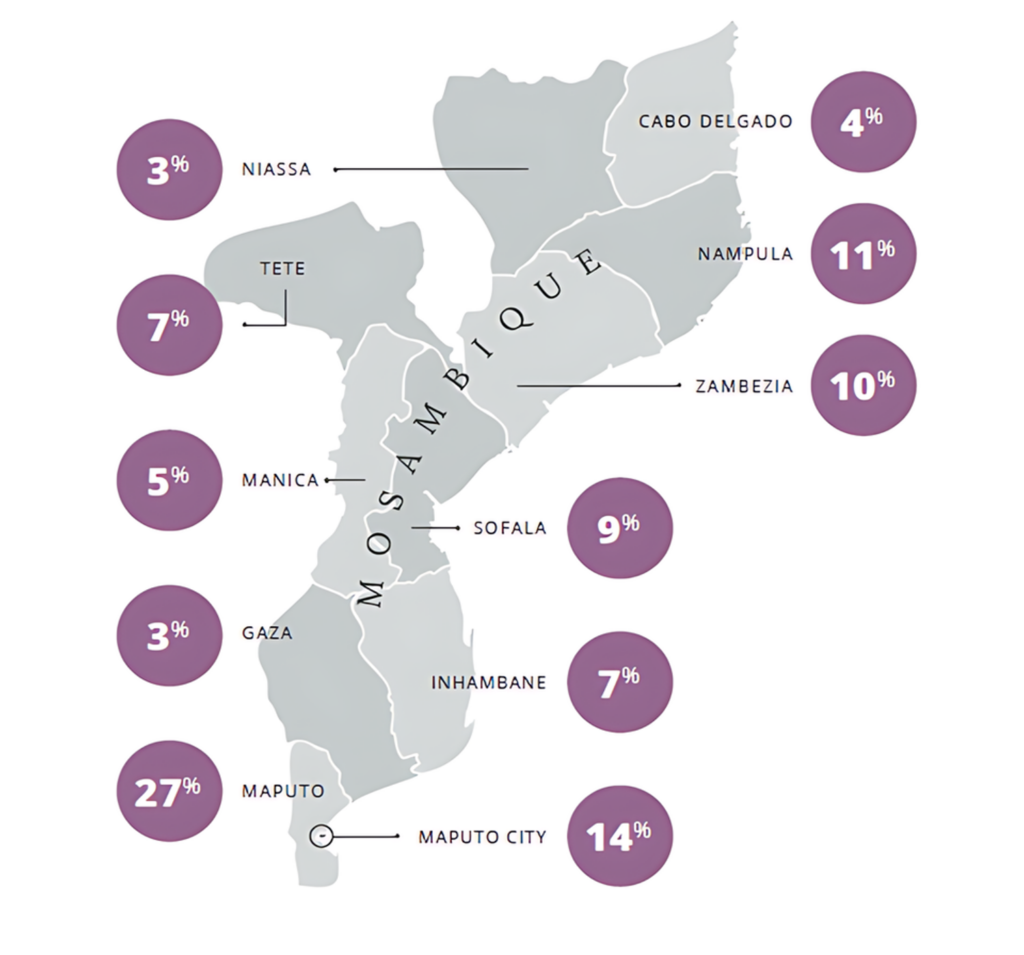
The distribution by gender was 77% male, 22% female, and 2% that specified “other.” Most respondents fell within the 25-34 age range at 61%, followed by the
16-24 age range at 23%, and the 35+ age range at 17%.
All 750 respondents included in the survey were required to own or otherwise have access to a smartphone.
Survey Findings
Key takeaways from the research include:
- Although 95% of respondents in this study personally own a smartphone and the remaining 5% have access to a smartphone owned by a spouse, family member, friend, etc., only 69% of respondents consider themselves the primary user of the smartphone (suggesting a significant number of shared devices).
- Slightly more men consider themselves the primary user (71%) compared to women (64%).
- Women are more likely than men to have just started using a smartphone within the past year (10% vs. 5%).
- Social media and messaging are by far the most widely installed and used smartphone apps across gender and age groups.
- Almost all respondents use Facebook (93%), and most use WhatsApp (81%) and SMS/text messaging (79%).
- Most smartphone users regardless of gender or age rely on mobile data as their primary means for accessing the internet (93%) and access the internet multiple times a day (88%).
- Most access social media multiple times a day (87%), primarily using their smartphone (79%), and spend at least 30 minutes each time they access it (72%).
- Data costs pose the biggest challenge to using social media and apps (69%), followed by internet connectivity (37%), and privacy concerns (31%).
- Perceptions of social media’s impact on local culture and society skew positive overall. A third of respondents believe the impact is very positive (32%), ranging from 39% for respondents ages 35+ to 24% for respondents ages 16-24.
- Most respondents across gender and age groups are using health-related apps or chats on their smartphone (84%), and almost all express at least some level of trust in the apps/chats they use.
- When asked which types of apps they would prioritize if they had limited time, money, or access to their phone, by far the largest segment of respondents said health apps (48%), rising to 52% for women.
Click here to download GeoPoll’s full written report on smartphone and social media usage in Mozambique.
About GeoPoll
GeoPoll provides full-service research solutions in more than 120 countries globally, focusing on low- and middle-income countries. Every year, GeoPoll completes over 5 million surveys via multiple mobile-based remote and in-person data collection modes, powered by a network of 10,000+ interviewers from 65 call centers, local teams, and direct partnerships with mobile network operators. Contact us to learn more about this study and our capabilities.
About Project Last Mile
If you can find an ice-cold Coca-Cola product almost anywhere in Africa, why not life-saving medicines? Project Last Mile is a global cross-sector partnership between donors, ministries of health, and the private sector that translates supply chain and marketing best practices from the Coca-Cola ecosystem into customized solutions for public health challenges. We focus on route-to- market, cold chain strengthening, and strategic marketing and communications. We aim to improve access, availability, and demand for life-saving medicines and health services down to the last mile in Africa. Since the first pilot in 2009, Project Last Mile has transformed into a leading public-private partnership for health. We have undertaken over 59 projects across 17 African countries, impacting the lives of more than 43 million people.
Find out more at www.projectlastmile.com.
The post Project Last Mile – Smartphone and Social Media Usage Landscape in Mozambique appeared first on GeoPoll.
]]>